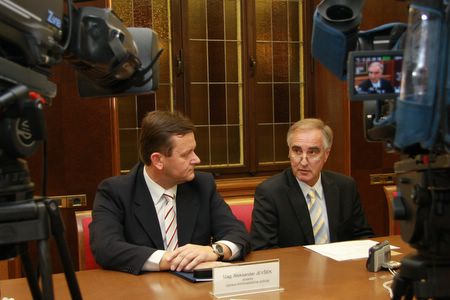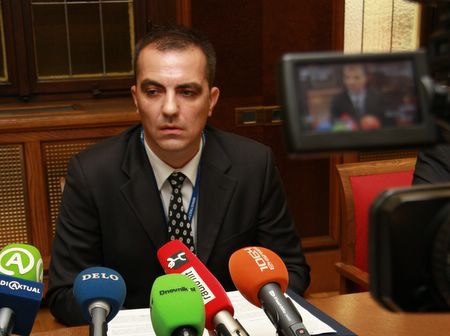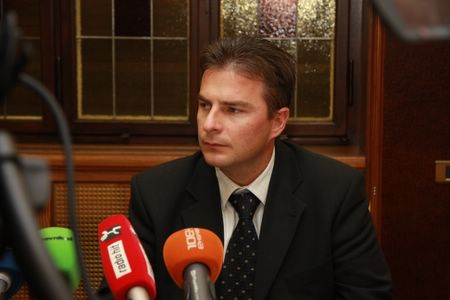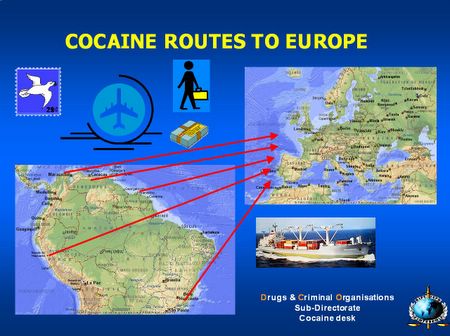Representatives of the General Police Directorate and the Customs Administration presented at a press conference a major drug seizure and the conclusions of a criminal investigation of an organised international gang, from which a number of suspects have been apprehended.

The press conference featured: the director of the Criminal Police Directorate at the General Police Directorate, Aleksander Jevšek Msc., the deputy head of the criminal police sector at the Police Directorate Koper, Dean Jurič, the director of the customs office Koper, Janko Strel, and the head of the local desk for analysis and control, Raniero Grando.

Customs officers in the port of Koper found more than 70 kilos of cocaine in bags of ceramic tile grout.

According to the representatives of the Customs Administration, customs officers in the port of Koper and members of the Koper mobile unit searched on 23 June 2008 two containers that arrived from Columbia. They were loaded with ceramic tile grout, which was destined to a sole proprietor from Slovenia. Among 3,217 bags of grout, there were also bags which appeared completely the same, but were lighter than other bags and the weight labelled on the bags. This was suspicious to the customs officers, who called the crime police to join the investigation. Crime officers analysed four lighter bags and it turned out that they contained cocaine. Fifty bags with suspicious content, weighing a total of 205.32 kilos, were found in the two containers.
Criminal investigation
According to police representatives, crime police officers from the criminal police sector at the Police Directorate Koper were informed on 23 June about the customs inspection of the shipment. They examined the accompanying documentation, which indicated that the containers were unloaded by a ship that arrived in the Koper port. They found by means of tracing that both containers were loaded in Baranquilla, Columbia, and unloaded in Jamaica on 8 May 2008, and then again loaded and on 14 June unloaded in the Port of Haifa, Israel. 16. June 2008, they were loaded on the Jork Valiant, which arrived in the Koper on 20 June. According to the documentation, the transport was arranged by a freight forwarder from Columbia.

Director of the Criminal Police Directorate at the General Police Directorate, Aleksander Jevšek Msc.

Deputy head of the criminal police sector at the Police Directorate Koper, Dean Jurič
The containers contained several pallets with plastic bags labelled with BLINDA CERAMIC BIANCO, BLINDA CERAMIC GRESE, BLINDA CERAMIC OCRE and containing unknown powdered substance suspected by the officers of the customs office Koper to be an illegal drug. Koper criminal police officers examined 32 inspected pallets (about 32 tonnes of ceramic tile grout) on the spot, separated and seized 50 bags which were suspected of containing a mixture of grout and cocaine. The Forensics Centre of the General Police Directorate analysed the substance and confirmed the suspicion that the substance in the bags contained cocaine. According to the Forensics Centre, the average concentration of cocaine was about 30%, which means that 72 kilos of cocaine could be isolated from the entire seized amount. Criminal police officers found that a 53-year-old Slovenian citizen from Murska Sobota was supposed to receive the illegal goods.

On the basis of established facts and evidence and founded reasons for suspicion, the officers acquired all necessary permission to carry out undercover investigative measures under the Criminal Procedure Act. The investigation established that the smuggling also involved other persons from Slovenia and other countries.

On 22 October 2008, the criminal investigation concluded with the arrests of the suspects and searches of apartments and other premises used by the suspects. On the basis of orders by the competent court, they made 9 house searches throughout Slovenia in the final operation. The criminal police detained three persons (the 53-year-old man, a 39-year-old man from Ljubljana, and a 32-year-old man from Kočevje) and used a criminal complaint to bring them before an investigating judge. Search warrants were issued for two persons (a 37-year-old man from Ljubljana and a 33-year-old man from Columbia) because they are on the run. Besides Koper customs and police officers, also contributing to the investigation were police officers from the police directorates of Nova Gorica, Ljubljana, Maribor, Celje, Murska Sobota and the Criminal Police Directorate at the General Police Directorate.

The police added at the press conference that the illegal drug was destined for users in the Netherlands. This case stands for a change of the classic cocaine route from the Andean region to Europe, as cocaine is usually smuggled directly into Rotterdam, and now drugs are smuggled into West and North Europe through the ports of the northern Adriatic. Street prices of cocaine in Slovenia range between EUR 50 and EUR 60 a gram, while the wholesale price stands at between EUR 30,000 and EUR 35,000 for a kilo.

Director of the customs office Koper Janko Strel

Head of the local desk for analysis and control Raniero Grando
Statistical data
In the first half of the year, the Slovenian police dealt with 1,011 criminal acts related to illegal drugs, which indicates that an increased number of such criminal acts will be recorded at the end of the year.
The global cocaine trade
The biggest producer of cocaine in the World in Columbia, which accounts for 62% of global production; 28% is produced in Peru, and 10% in Bolivia. The majority of this cocaine is destined for the US and Western Europe, which are also the biggest markets for this drug. About a half of all seizures in Europe are carried out in Spain, followed by the Netherlands and Portugal. These countries are the entry points for cocaine to the EU. Cocaine smuggling routes to Europe also lead from Africa, primarily through Sierra Leone, Nigeria, South Africa, Liberia, Cote d'Ivoire, etc. Cocaine smuggling on the so-called fishing boat route takes place between Cape Verde and the African continent. There are two options: if cocaine comes directly from South America, it is smuggled to the south of Cape Verde, and if it smuggled from warehouses in Africa, a direct route for Spain is used. Smugglers use fishing boats under the flags of American or African countries. The route is controlled by smugglers from Latin America and Africa, together with Europeans.

Various gangs which smuggle cocaine from South America are connected with each other. Columbians are connected with Mexicans, Spaniards, Moroccans, Senegalese, Ghanaians and Togolese. Columbian organisers take care for delivery of cocaine to Mexican gangs and to Panama. Gangs from Brazil, Lebanon and Nigeria are also connected. Brazilian cocaine is exchanged for ecstasy in Belgium and the Netherlands. Brazilian gangs operating in Paraguay smuggle weapons from the EU and Asia and exchange them for cocaine.

